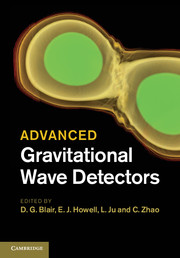Book contents
- Frontmatter
- Contents
- List of contributors
- Foreword
- Preface
- Introduction
- Part 1 An introduction to gravitational wave astronomy and detectors
- Part 2 Current laser interferometer detectors – three case studies
- Part 3 Technology for advanced gravitational wave detectors
- 9 Lasers for high optical power interferometers
- 10 Thermal noise, suspensions and test masses
- 11 Vibration isolation
- 12 Interferometer sensing and control
- 13 Stabilising interferometers against high optical power effects
- Part 4 Technology for third generation gravitational wave detectors
- Index
12 - Interferometer sensing and control
from Part 3 - Technology for advanced gravitational wave detectors
Published online by Cambridge University Press: 05 March 2012
- Frontmatter
- Contents
- List of contributors
- Foreword
- Preface
- Introduction
- Part 1 An introduction to gravitational wave astronomy and detectors
- Part 2 Current laser interferometer detectors – three case studies
- Part 3 Technology for advanced gravitational wave detectors
- 9 Lasers for high optical power interferometers
- 10 Thermal noise, suspensions and test masses
- 11 Vibration isolation
- 12 Interferometer sensing and control
- 13 Stabilising interferometers against high optical power effects
- Part 4 Technology for third generation gravitational wave detectors
- Index
Summary
Advanced gravitational wave detectors require sophisticated sensing and control systems in order to acquire and maintain synchronous operation of the various optical cavities. This chapter will firstly provide some mathematical background, before discussing the sensing and control of both the lengths and angular orientation of the various components of the optical configuration. We will also describe how the modulation frequencies are calculated before discussing further issues of control relevant to the signal recycling cavity and the readout scheme.
Introduction
The topology of the first generation of interferometers is based on that of a Michelson interferometer with Fabry–Perot cavities coupled as arm cavities and a power recycling cavity (PRC) to increase its sensitivity. As we have learned in previous chapters, the design of advanced gravitational wave (GW) detectors will be based on a configuration known as dual-recycling through the addition of a signal recycling (extraction) cavity (SRC). The improvement also includes input laser power a factor of ten greater than that of the first generation, stable recycling cavities, as well as very complex suspensions and seismic isolation systems.
The power recycling mirror (PRM) creates a composite cavity (PRC) with the common mode of the arm cavities, while the signal recycling mirror (SRM) creates another composite cavity (SRC) with the interferometer differential mode. The transmittance and reflectivity of the compound mirror formed by the SRM and the input test mass (ITM) is dependent on frequency. In signal recycling (SR), this cavity is tuned so that the GW signal will produce a lower transmittance (higher reflectivity) than that of the ITM alone (Meers, 1988).
Information
- Type
- Chapter
- Information
- Advanced Gravitational Wave Detectors , pp. 227 - 243Publisher: Cambridge University PressPrint publication year: 2012
